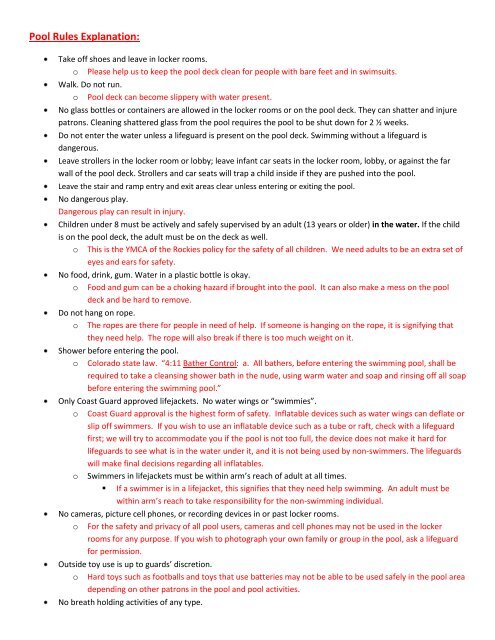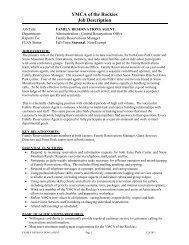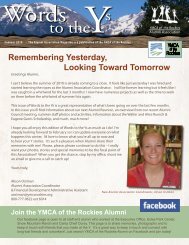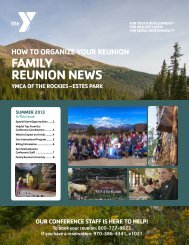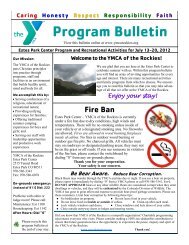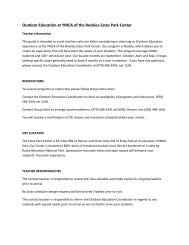Pool Rules Explanation: - YMCA of the Rockies
Pool Rules Explanation: - YMCA of the Rockies
Pool Rules Explanation: - YMCA of the Rockies
You also want an ePaper? Increase the reach of your titles
YUMPU automatically turns print PDFs into web optimized ePapers that Google loves.
<strong>Pool</strong> <strong>Rules</strong> <strong>Explanation</strong>:<br />
Take <strong>of</strong>f shoes and leave in locker rooms.<br />
o Please help us to keep <strong>the</strong> pool deck clean for people with bare feet and in swimsuits.<br />
Walk. Do not run.<br />
o <strong>Pool</strong> deck can become slippery with water present.<br />
No glass bottles or containers are allowed in <strong>the</strong> locker rooms or on <strong>the</strong> pool deck. They can shatter and injure<br />
patrons. Cleaning shattered glass from <strong>the</strong> pool requires <strong>the</strong> pool to be shut down for 2 ½ weeks.<br />
Do not enter <strong>the</strong> water unless a lifeguard is present on <strong>the</strong> pool deck. Swimming without a lifeguard is<br />
dangerous.<br />
Leave strollers in <strong>the</strong> locker room or lobby; leave infant car seats in <strong>the</strong> locker room, lobby, or against <strong>the</strong> far<br />
wall <strong>of</strong> <strong>the</strong> pool deck. Strollers and car seats will trap a child inside if <strong>the</strong>y are pushed into <strong>the</strong> pool.<br />
Leave <strong>the</strong> stair and ramp entry and exit areas clear unless entering or exiting <strong>the</strong> pool.<br />
No dangerous play.<br />
Dangerous play can result in injury.<br />
Children under 8 must be actively and safely supervised by an adult (13 years or older) in <strong>the</strong> water. If <strong>the</strong> child<br />
is on <strong>the</strong> pool deck, <strong>the</strong> adult must be on <strong>the</strong> deck as well.<br />
o This is <strong>the</strong> <strong>YMCA</strong> <strong>of</strong> <strong>the</strong> <strong>Rockies</strong> policy for <strong>the</strong> safety <strong>of</strong> all children. We need adults to be an extra set <strong>of</strong><br />
eyes and ears for safety.<br />
No food, drink, gum. Water in a plastic bottle is okay.<br />
o Food and gum can be a choking hazard if brought into <strong>the</strong> pool. It can also make a mess on <strong>the</strong> pool<br />
deck and be hard to remove.<br />
Do not hang on rope.<br />
o The ropes are <strong>the</strong>re for people in need <strong>of</strong> help. If someone is hanging on <strong>the</strong> rope, it is signifying that<br />
<strong>the</strong>y need help. The rope will also break if <strong>the</strong>re is too much weight on it.<br />
Shower before entering <strong>the</strong> pool.<br />
o Colorado state law. “4:11 Ba<strong>the</strong>r Control: a. All ba<strong>the</strong>rs, before entering <strong>the</strong> swimming pool, shall be<br />
required to take a cleansing shower bath in <strong>the</strong> nude, using warm water and soap and rinsing <strong>of</strong>f all soap<br />
before entering <strong>the</strong> swimming pool.”<br />
Only Coast Guard approved lifejackets. No water wings or “swimmies”.<br />
o Coast Guard approval is <strong>the</strong> highest form <strong>of</strong> safety. Inflatable devices such as water wings can deflate or<br />
slip <strong>of</strong>f swimmers. If you wish to use an inflatable device such as a tube or raft, check with a lifeguard<br />
first; we will try to accommodate you if <strong>the</strong> pool is not too full, <strong>the</strong> device does not make it hard for<br />
lifeguards to see what is in <strong>the</strong> water under it, and it is not being used by non-swimmers. The lifeguards<br />
will make final decisions regarding all inflatables.<br />
o Swimmers in lifejackets must be within arm’s reach <strong>of</strong> adult at all times.<br />
• If a swimmer is in a lifejacket, this signifies that <strong>the</strong>y need help swimming. An adult must be<br />
within arm’s reach to take responsibility for <strong>the</strong> non-swimming individual.<br />
No cameras, picture cell phones, or recording devices in or past locker rooms.<br />
o For <strong>the</strong> safety and privacy <strong>of</strong> all pool users, cameras and cell phones may not be used in <strong>the</strong> locker<br />
rooms for any purpose. If you wish to photograph your own family or group in <strong>the</strong> pool, ask a lifeguard<br />
for permission.<br />
Outside toy use is up to guards’ discretion.<br />
o Hard toys such as footballs and toys that use batteries may not be able to be used safely in <strong>the</strong> pool area<br />
depending on o<strong>the</strong>r patrons in <strong>the</strong> pool and pool activities.<br />
No breath holding activities <strong>of</strong> any type.
o<br />
Blackouts can happen when someone holds <strong>the</strong>ir breath too long. We do not allow patrons to hold <strong>the</strong>ir<br />
breath for longer than 10 seconds.<br />
A 10 minute break every hour is up to <strong>the</strong> guards’ discretion.<br />
o During busy times, when a lifeguard is on <strong>the</strong> stand for more than one hour, a 10 minute safety break<br />
can be called to clear <strong>the</strong> pool. This allows <strong>the</strong> lifeguards to take a break from scanning, use <strong>the</strong> rest<br />
room and check <strong>the</strong> bottom <strong>of</strong> <strong>the</strong> pool for safety issues.<br />
Lifeguards have final discretion regarding pool rules and policies.<br />
o Lifeguards making reasonable safety decisions will have <strong>the</strong> full backing <strong>of</strong> <strong>the</strong> Aquatics Director.<br />
Do not swim when you have diarrhea. You can spread germs in <strong>the</strong> water and make o<strong>the</strong>r people sick.<br />
Do not swallow <strong>the</strong> pool water. Avoid getting water in your mouth. This prevents germs from spreading.<br />
Practice good hygiene. Take a shower before swimming and wash your hands after using <strong>the</strong> toilet or changing<br />
diapers. This prevents germs from spreading.<br />
Take children on bathroom breaks or check diapers <strong>of</strong>ten. Waiting to hear “I have to go” may mean that it’s too<br />
late. This prevents germs from spreading.<br />
Change diapers in a bathroom or a diaper-changing area and not at poolside. This prevents germs from<br />
spreading.<br />
Wash your child thoroughly (especially <strong>the</strong> rear end) with soap and water before swimming. This prevents germs<br />
from spreading.<br />
Non toilet-trained children must wear a swim diaper under a tight-fitting swimsuit. This prevents accidental fecal<br />
releases into <strong>the</strong> pool.<br />
Diving <strong>Rules</strong>:<br />
Slide <strong>Rules</strong>:<br />
Standing dives only. No flips, twisting jumps, or back dives permitted.<br />
o Flips, twists and back dives can result in a collision with <strong>the</strong> side <strong>of</strong> <strong>the</strong> pool.<br />
Dive from edge <strong>of</strong> <strong>the</strong> pool. No running or hurdle steps to dive in.<br />
o Running and hurdle steps may cause <strong>the</strong> swimmer to slip and fall.<br />
Do not dive between red lines on <strong>the</strong> bottom <strong>of</strong> <strong>the</strong> pool.<br />
o The red lines on <strong>the</strong> bottom <strong>of</strong> <strong>the</strong> pool indicate <strong>the</strong> slope into <strong>the</strong> deep end. This area is less than 9 feet deep.<br />
<strong>Pool</strong> users must pass <strong>the</strong> deep water swim test to use diving well.<br />
o Only confident and capable swimmers are allowed to swim in deep water.<br />
Make sure <strong>the</strong> diving area is clear.<br />
o To ensure <strong>the</strong>re is not a collision with a swimmer in <strong>the</strong> water.<br />
No floatation devices in <strong>the</strong> diving well o<strong>the</strong>r than adult fitness devices<br />
o Non-swimmers and tired swimmers rely on floatation devices. If <strong>the</strong> floatation device is taken away<br />
without notice, this could impact <strong>the</strong> swimmers ability to swim in <strong>the</strong> deep end. Coast Guard approved<br />
lifejackets are acceptable for swimmers using <strong>the</strong> slide.<br />
Swimmers must pass <strong>the</strong> deep water swim test to use <strong>the</strong> slide without wearing a life jacket, or a swimmer may<br />
wear a life jacket while using <strong>the</strong> slide if <strong>the</strong> swimmer has an adult in <strong>the</strong> water near <strong>the</strong> end <strong>of</strong> <strong>the</strong> slide to<br />
“catch” <strong>the</strong> swimmer and immediately exit <strong>the</strong> deep end <strong>of</strong> <strong>the</strong> pool.<br />
o The slide exits into <strong>the</strong> deep end <strong>of</strong> <strong>the</strong> pool.<br />
A lifeguard must be present for slide to be in use.<br />
o A lifeguard must monitor <strong>the</strong> entry and exit <strong>of</strong> <strong>the</strong> slide at all times to make sure it is safe and secure for<br />
patrons.<br />
Go feet first only down <strong>the</strong> slide.
o<br />
Sauna <strong>Rules</strong>:<br />
This allows <strong>the</strong> feet to break <strong>the</strong> surface <strong>of</strong> <strong>the</strong> water so <strong>the</strong> impact is not too great.<br />
Clear bottom <strong>of</strong> slide area quickly after exiting slide- swim to <strong>the</strong> left and exit at ladder<br />
o This allows for lifeguard to account for patrons’ safety and <strong>the</strong> next patron to be able to slide quickly.<br />
Limit <strong>of</strong> 15 people.<br />
o There is seating room for only 15 people. People should not be standing because <strong>of</strong> <strong>the</strong> chance <strong>of</strong> being<br />
pushed into <strong>the</strong> heating unit, tripping and falling, or fainting.<br />
Use for 10 minutes at a time.<br />
o Longer periods <strong>of</strong> time can result in dehydration and heat exhaustion.<br />
Must be 13 years <strong>of</strong> age or older.<br />
o Children that have not gone through puberty do not have <strong>the</strong> same heat regulating internal systems that<br />
adults have. They are likely to be victims <strong>of</strong> dehydration and heat exhaustion.<br />
Do not use if you are pregnant, taking prescription medicines, have elevated blood pressure, diabetes, heart<br />
disease, history <strong>of</strong> epileptic seizures, under <strong>the</strong> influence <strong>of</strong> alcohol, or are dehydrated.<br />
o Excessive heat can aggravate <strong>the</strong> above-mentioned conditions.<br />
Sit on a towel while using <strong>the</strong> sauna.<br />
o This keeps it sanitary for <strong>the</strong> next user.<br />
Shower before re-entering <strong>the</strong> pool.<br />
o This washes <strong>of</strong>f <strong>the</strong> sweat produced in <strong>the</strong> sauna and helps keep <strong>the</strong> pool clean.<br />
Aerobic exercise is prohibited in <strong>the</strong> sauna. This can potentially make <strong>the</strong> user become ill.<br />
Do not fill cup with pool water. Use only fresh water provided from bucket.<br />
o The bucket is filled with fresh water to make clean steam for patrons to brea<strong>the</strong> in.


